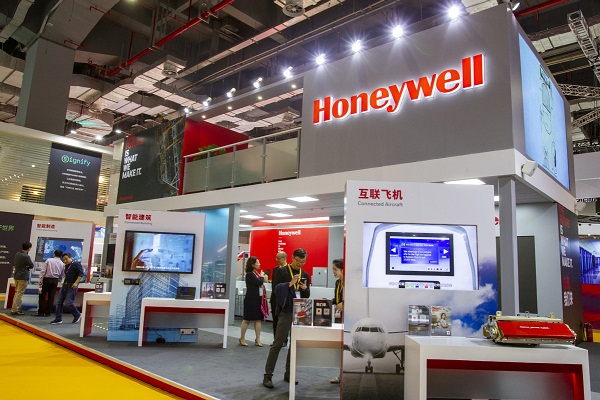Honeywell launches low-carbon R&D center

Visitors gather at the Honeywell booth during a trade fair in Shanghai. [Photo by Lyu Liang/For China Daily]
US conglomerate Honeywell announced recently the establishment of a low-carbon research center in China which aims to offer low-carbon solutions that can help facilitate the country's efforts to achieve carbon neutrality by 2060.
Located in Shanghai, the Honeywell China Sustainability Research Institute Low Carbon Center is the first of its kind in the company's global architecture. It focuses on six key technical fields: new energy, renewable resources, material recycling, carbon capture, utilization and storage.
"The launch of the Low Carbon Center is not only driven by global climate governance and China's dual carbon goals, but also a strong manifestation of Honeywell's continuously increasing investment in environmental, social and corporate governance," said Henry Liu, vice-president and general manager of Honeywell Performance Materials and Technologies for Asia-Pacific. "We view China not only as a market, but an important source of innovation."
The low carbon center will regularly publish white papers and research reports on advanced low-carbon technologies, products, and services. Ideally, it will become a platform for low-carbon research projects between Honeywell and government departments, enterprises, research institutions, industry organizations and universities in China.
According to Liu, ESG is increasingly becoming a factor in business decision-making among Chinese entrepreneurs, and more priorities are given to the low-carbon field during government approvals of projects.
"What's more important, reducing emissions itself is the best way to conduct supply-chain structural reform. Beyond being a good deed, it's bringing companies substantial benefits," Liu said.
While profitability is not the top target for the center, some of the technologies are already helping clients save costs and in turn improving profitability, said Zhou Lubo, chief technology officer of Honeywell PMT Asia-Pacific and director of the Honeywell China Sustainability Research Institute.
"For instance, the propane dehydrogenation technology can help customers like those in the fossil energy industries use less raw materials and consequently consume less energy, thus enhancing production efficiency," Zhou said.
He identified technologies to increase hydrocarbon conversion efficiency and reduce energy consumption, as well as those for the production of renewable diesel fuel to be among the most promising to bear fruit in China.
Honeywell has set a target of becoming carbon neutral in its operations and facilities by 2035.As part of its efforts, around half of new product R&D at Honeywell is directed toward products that can help improve environmental and social outcomes for customers.
Liu said the company is highly supportive of China's establishment of a carbon trading market in July, a move that shows China's solemn commitment toward low-carbon development and provides companies with advanced technologies a substantial bonus.
As more renewable energy sources are used for power generation, the proportion of China's non-fossil energy generation is projected increase to about 45 percent by 2030, according to consultancy Bain&Co. The number was around 30 percent last year, according to the National Energy Administration.
"In the later period of the 14th Five-Year Plan (2021-25), key emissions industries such as steel, cement, aviation and chemicals will gradually be included in the carbon trading market, making the carbon emissions trading mechanism a key policy tool to realize carbon emissions reduction targets," said Thomas Luedi, senior partner at Bain in Shanghai.


 China's public holidays for 2025
China's public holidays for 2025  Shanghai FTZ: Go all out to build China's first pilot zone for Silk Road E-commerce cooperation
Shanghai FTZ: Go all out to build China's first pilot zone for Silk Road E-commerce cooperation  Favorable policies boost 'China Travel' trend
Favorable policies boost 'China Travel' trend  play
play 